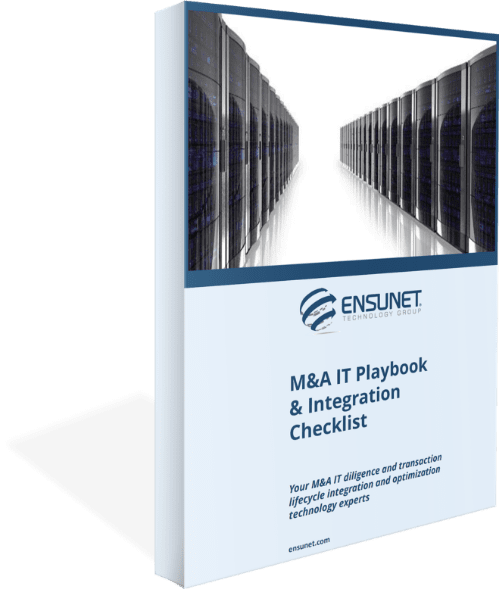M&A IT Playbook & Integration Checklist
Free M&A IT Playbook & Integration Checklist

M&A IT Playbook & Integration Checklist


A major multinational enterprise recently acquired a portion of another company—what’s known as a “carve-out” in the mergers-and-acquisitions, or M&A, world. Migrating all of the acquired company’s data, housed in hundreds of servers and scores of datacenters, is the kind of challenge that Ensunet excels at; it’s why we were tapped for this high-stakes project.
This is where the rubber meets the road in the realm of post-merger integration, or PMI. There’s an ironclad transition services agreement, or TSA, in place; it dictates the terms and conditions of the integration, with rigorous deadlines and steep financial penalties for missing them. Conversely, there’s money to be saved, and goodwill to be earned, if you exceed expectations.
To get the inside story of this global project, we recently sat down with Ensunet’s own Cathy Garcia. An IT veteran who previously served for decades as a senior leader at one of the world’s largest aero/defense enterprises, she was the Project Manager on this initiative, among the many other hats she wore.
Spoiler alert: Ensunet absolutely blew away the client by bringing this project in early, despite a little bump in the road that happened along the way... in the form of a global pandemic lockdown!
Company A, meet Company B
The acquired carve-out entity—the valuable portion of a bigger concern which Company A wanted to buy—specializes in the realm of predictive analytics for the vertical in which Company A competes. For the purposes of this article, we’ll refer to the carved-out entity as “Company B.”
Company B, as you might guess, is very R&D-heavy. This is what allows them to produce such a cutting-edge product.
R&D presents its own special PMI challenge. It’s a balancing act: You want those researchers to have unfettered access to the latest technology in order to do their jobs. But at the same time, the instant the acquisition is announced, they become a ripe target for bad actors, so you need extra levels of security to protect that asset.
The scope—and IT footprints—in this story are massive:
Making this happen required a lot of careful foresight.
The migration plan
Cathy and her team were originally given a big list of assets: servers, firewalls, tag numbers. The first thing to do was to make sense of it all.
For example, the list wasn’t always accurate. This involved contacting Company B people in the given regions, and simply asking them, “Does that piece of equipment actually exist?”
The next step was akin to triage. The Ensunet team devised four levels of use cases by which to categorize the Company B assets and their eventual destination/disposition:
That’s an overly-simplified version of what we did. Because some of the migration—including internally at Company A—involved moving physical assets to the cloud.
Note that this goes way beyond “project management.” As Cathy puts it, “You have to be willing to get your hands dirty. There’s definitely a systems-integration component to this.” In other words, you need to put skin into the game in order to exceed the client’s expectations.
Everything was ready to go... when COVID-19 struck and the world changed.
The best-laid plans...
Once the pandemic hit, the notion of “boots on the ground” changed radically. Travel was restricted. And Company A locked down its facilities, beyond what was required by government. In many cases, people couldn’t even enter the datacenters.
So planned strategy sessions, workshops, and other face-to-face interactions quickly went virtual. “You spend your life on Skype and MS Teams,” as Cathy put it. Dealing with globally dispersed teams also means long hours to accommodate different time zones. There were language barriers, too: Some teams in other countries responded better to written instructions vs. verbal ones.
There were also work-arounds. For example, physical firewalls would be configured remotely, and then shipped to regions where the actual servers resided, where “smart hands” (local tech talent) would be directed to literally hook them up, sometimes with video cameras in hand, to make sure all the connections were done right.
Making it all work
A global undertaking like this would be a challenge in the best of times. Doing it during a pandemic was obviously trickier.
Yet the Ensunet team, as usual, exceeded client expectations. We configured the site in Germany a month early. We closed out one of the U.S.sites seven months early. The client mentioned to us that, for that single site, our deadline-beating effort saved them $130,000 a month.
Post-merger integration is a high-stakes game. And IT is central to its success. At Ensunet, we understand the nuances of IT for M&A because we’ve supported billions in PMI activity. We can help you, too. Download our free M&A IT Playbook & Integration Checklist. Or contact us today for a free, no-obligation consultation with one of our friendly subject-matter experts.
Reach out to the world’s most reliable IT services.